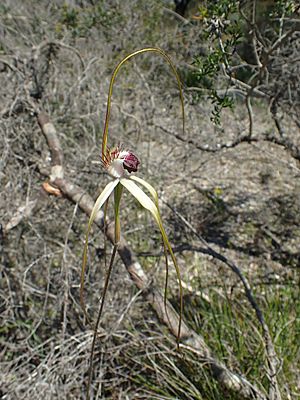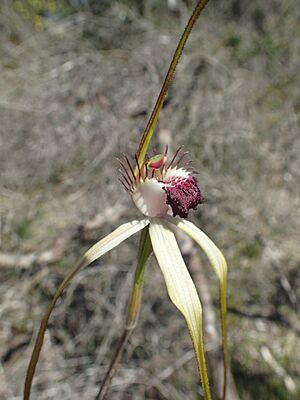Giant spider orchid facts for kids
Quick facts for kids Giant spider orchid |
|
|---|---|
 |
|
| Caladenia excelsa growing near Yallingup | |
| Conservation status | |
| Scientific classification | |
| Genus: |
Caladenia
|
| Species: |
excelsa
|
| Synonyms | |
|
|
The Caladenia excelsa, also known as the giant spider orchid, is a special type of orchid. It is only found in a small part of Western Australia. This orchid is quite rare.
It has a single, fuzzy leaf. Its flowers are cream-coloured or greenish-cream. They have long, hanging parts called sepals and petals. This orchid is one of the tallest spider orchids in Western Australia. It also has some of the biggest flowers of any orchid in the state, along with the Caladenia splendens.
Contents
What Does the Giant Spider Orchid Look Like?
The giant spider orchid is a plant that grows from an underground tuber. It is a perennial plant, meaning it lives for more than two years. It is also deciduous, so its leaves fall off at certain times.
It has one upright, hairy leaf. This leaf can be about 20 to 35 centimetres (8 to 14 inches) long. It is usually about 6 to 12 millimetres (0.2 to 0.5 inches) wide.
The plant grows one or two flowers on a tall stalk. This stalk can be 45 to 90 centimetres (18 to 35 inches) high. The flowers themselves are quite large. They can be 15 to 30 centimetres (6 to 12 inches) long. They are also 7 to 15 centimetres (3 to 6 inches) wide.
The sepals and petals of the flower have long, thin, brownish tips. These tips hang downwards. The top sepal curves back behind the flower. It is about 13 to 20 centimetres (5 to 8 inches) long. The side sepals are also 13 to 20 centimetres long. The petals are a bit shorter, about 9.5 to 15 centimetres (4 to 6 inches) long.
The labellum is a special lip-like part of the flower. It is creamy-coloured with a red tip. The labellum is about 2.5 to 3.5 centimetres (1 to 1.4 inches) long. It has many thin "teeth" along its sides. These teeth can be up to 1 centimetre (0.4 inches) long. There are also four rows of maroon or white bumps, called calli, along the middle of the labellum.
This orchid usually flowers from late September to early November.
How It Got Its Name
The Caladenia excelsa was first described in 2001. Two scientists, Stephen Hopper and Andrew Brown, gave it its scientific name. They found a sample of the orchid near Margaret River.
The second part of its name, excelsa, comes from a Latin word. It means "high" or "lofty." This name was chosen because the orchid's flower stalk is very tall.
Where the Giant Spider Orchid Lives
The giant spider orchid grows in a specific area of Western Australia. You can find it between Dunsborough and Karridale.
It prefers to grow in forests. It likes deep, sandy soils. This area is part of the Jarrah Forest and Warren regions. These are areas with similar plants and animals.
Protecting the Giant Spider Orchid
The giant spider orchid is a rare and important plant. The Western Australian Government protects it. They list it as "Threatened Flora." This means it is a rare plant that needs special care.
The Australian Government also lists it as "Endangered." This is under a law called the Environment Protection and Biodiversity Conservation Act 1999. Being endangered means it is at a very high risk of disappearing forever.
There are a few things that threaten this special orchid:
- Weed invasion: Weeds can grow and take over the space the orchid needs.
- Grazing: Animals like the Western grey kangaroo sometimes eat the orchids.
- Prescribed burning: Controlled fires can sometimes harm the plants.
- Infrastructure maintenance: Work on roads or buildings can disturb their habitat.
Because of these threats, people are working to protect the giant spider orchid. This helps make sure it can continue to grow in Western Australia.



